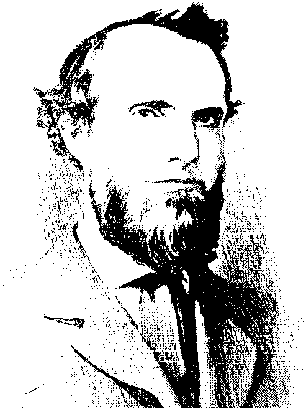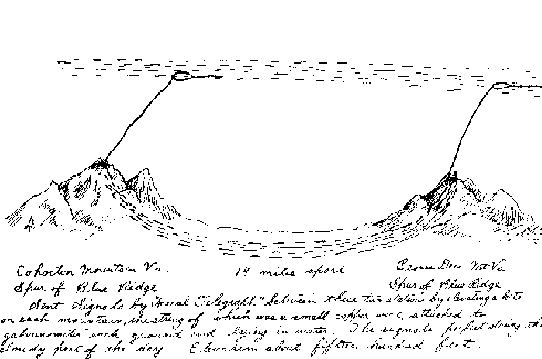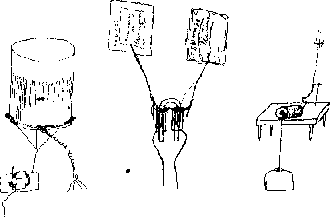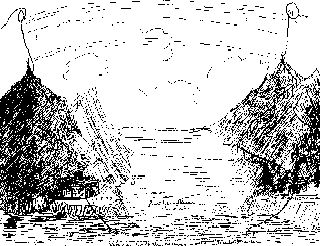| Mahlon Loomis - First Wireless Telegrapher
Copyright Edward A. Sharpe, Archivist SMEC 1989 ( now SMECC 2003) |
|
Mahlon Loomis - The First Wireless Telegrapher |
|
Drawing done by Mahlon Loomis, showing
14 miles between mountains. |
| As it is with any event in history, invention of a process is seldom the responsibility of only one singular person. Radio, as we know it, has been attributed to Guglimo Marconi, however his success was built upon the works of Hertz, Lodge and Branley, and others. Let us now take a trip back into history, Letís even go back before Marconi was a twinkle in his parentís eye! The Early Days Mahlon Loomis was born July 21, 1826, in Oppenhiem New York, into the family of Professor Nathan Loomis and Waitie Loomis. He was the fourth of nine children. Not a lot of details are available about Mahlon Loomisí early life. This is unfortunate because it is often interesting to see how a young inventive mind grows. We do, however, know that he was surrounded by educated minds, as his father was a founder of the AMERICAN EPHEMERIS and NATIONAL ALMANAC. In addition to this, his older brother George, was an inventor and holder of several patents himself. In 1836, Mahlonís family moved to Springvale, Virginia. In September of 1848, Mahlon went to Cleveland, Ohio to partake in the study of dentistry. In 1850, he returned to Springvale to continue his dental work. For several years Mahlon spent time as a traveling dentist. During this time he went to Earlville, New York, Cambridgeport Massachusetts and Philadelphia. During this practice in Massachusetts he received a patent for a mineral plate (Kaolin ) process for the making of artificial teeth. In November of 1856, Loomis and his bride of only a few months, Achsah Ashley, settled in Washington D.C. to set up a dentistry practice. The Start Of The Electrical Days About 1860, Mahlon Loomis became interested in electricity, and his first application of this was an experiment in the forced increase of growth in plants. This was achieved by buried metal plates connected to an electrical current furnished by batteries. In this same time period Mahlon became interested in using the electrical charges obtainable from the upper atmosphere by means of kites carrying metal wires. At first he planned to use this natural source of electricity to replace batteries on a telegraph circuit. It is noted in many references that this was something that was actually achieved on a telegraph line that was 400 miles long. Later on, from experiments in this area, Mahlon discovered that a kite sent aloft would affect the flow of current in another kite that was some distance away from the first kite. This set him on a path of developing it as a system of wireless telegraphy for practical long distance communications. It Actually Works! The year is 1868, and Mahlon Loomis demonstrates to a group of Congressmen and eminent scientists a wireless "communication" system between two sites 14 to 18 miles apart. There seems to be some discrepancy as to the distance in the various records that exist, however in the picture that was drawn by Mahlon Loomis, 14 miles is mentioned. This and many other pictures and notes are on file in the Library of Congress. From one mountain peak he sent up a kite, the bottom of which was covered with thin copper gauze, and the kite string was copper wire. He connected this apparatus up to a galvometer that had the other end of the circuit connected to ground. Immediately the galvometer showed the passage of current! He then set up an identical outfit on a mountain peak 18 miles away, to send. He would touch this second kites wire to ground and by this action reduced the voltage of the charged stratum and lowered the deflection in the galvometer attached to the other kite at first location we discussed. There were problems with the communications system sometimes. It seemed that if one of the kites was at the wrong height, the system would not work. This led Loomis to believe that there were different areas in the atmosphere, and depending which area you were in, would control if the communication would work or not. There were even days when the system just would not work at all. In thinking about that, I suppose it could be due to the electrostatic charge in the atmosphere that existed at that time during the experiment. Mahlon Seeks the Governmentís Help Senator Charles Sumner, encouraged by a previous government grant to Samuel F.B. Morse, introduced a bill into the Senate on January 13, 1869. The "Loomis Aerial Telegraph Bill" asked for an act of incorporation for the Loomis Aerial Telegraph Company, and for the appropriation of $50,000 to help perfect Loomisís discovery and make it practical. Loomis had proposed a system where wireless telegraph messages could be sent across the Atlantic at 1/16 the cost of what it was using a Trans-Atlantic cable. In an address to Congress, Loomis explained his system worked by: "Causing electrical vibrations or waves to pass around the world, as upon the surface of some quiet lake one wave circlet follows another from the point of the disturbance to the remotest shores, so that from any other mountain top upon the globe another conductor, which shall pierce this plane and receive the impressed vibration, may be connected to an indicator which will mark the length and duration of the vibration; and indicate by any agreed system of notation, convertible into human language, the message of the operator at the point of the first disturbance." The bill, although gaining the support of a few Congressmen, was thought to be a fraud by many others. It was shuttled from committee to committee with much delay. On May 20 thru 21, 1872, a lengthy discussion took place in the House. The issue of appropriations had been removed from the bill, and issue of incorporation was all that remained of the Loomis bill. The newspapers became extremely active on the Loomis issue, unfortunately the majority of them were not favorable to the concept of wireless communication. Their reports ranged from polite skepticism to outright ridicule and allegations of the Loomis method being a fraud! A copy of the Loomis Bill was also submitted to the committee for patents. On July 30, 1872, Patent number 129,971 was issued to Mahlon Loomis. On January 6, 1873, the Loomis Bill was brought to a vote in the Senate and passed by a vote of 29 to 12, with 33 Senators absent. The record shows that neither of Virginia's Senators voted for the bill, despite the fact that Loomis was a resident there. Five days later the bill was signed into law by President Grant, thus incorporating the Loomis Aerial Telegraph Company. What had been achieved by this? Actually, not very much! Although Loomis now had a legal corporation, it was not allowed to operate outside Washington D.C. with out the prior consent of the state the corporation wished to operate within. The Twilight Years During the later years of his life, Mahlon worked as a dentist only to the extent to get some more capital to use to purchase goods for his electrical and communications experiments. In the late 1870ís a distance was obtained of 20 miles. In this experiment he erected steel masts on top of wooden towers (these replaced the kites of the earlier experiments) and reportably maintained fairly reliable communications for periods of months at a time. There was even some hints in his notes about experimenting with a "Wireless Telephone". There do not seem to be any surviving details of these experiments however, so it is really hard to say if he met with any successes in this area or not. There are also drawings of buzzers connected to the Loomis system. Was this the start of an idea never finished? Twilight Fades to Dark Mahlon Loomis was heard to say many time the following statement: "I know that I am regarded as a crank, perhaps a fool by some, and as to the latter, possibly I am, for I could have discarded this thing entirely and turned my attention to making money." "I have not only discovered a new world, but the means to invade it. My compensation is poverty, contempt, neglect, forgetfulness. In the distant future, when the possibilities of this discovery are more fully developed, public attention will be directed to itís originator, and the congressional records will furnish the indisputable proof that the credit belongs to me." On October 13,1886, after a weeks long illness, Mahlon Loomis died at his brotherís country home in Terra Alta, West Virginia ; he was 60 years old. During the illness, his brother George reported that Mahlon was in hopes that the world would realize and use his invention. George Loomis also told others his brother's thoughts as Mahlonís life neared itís end...... "I know that I am by some, even many, regarded as a crank - by some perhaps a fool.... But I know that I am right, and if the present generation lives long enough their opinions will be changed - and their wonder will be that they did not perceive it before. I shall never see it perfected - but it will be, and others will have the honor of the discovery " The Aftermath What is Loomisís place in communications history? At the very least there are several areas he should receive credit for. 1. First to use a complete antenna and ground system 2. First experimental transmission of wireless telegraph signals. 3. The first use of kites to carry an antenna aloft. 4. The first use of balloons to raise an antenna wire. 5. First vertical antenna (steel rod mounted on top of a wood tower). 6. Formulation of the idea of Ďwavesí traveling out from his antenna. 7. The first Patent for wireless telegraphy. His actions did not catch the attention of the world as those experiments and successes that Marconi had. It almost seems that he was just a generation ahead of his time. The wireless system that was to happen had to wait another generation until there would be a bit more knowledge to draw upon to bring it to itís fulfillment and usefulness. Who is to know though, what the publicity that surrounded his experiments may have done to inspire other people. It is often a chain reaction, once an idea is brought to light, and it inspires other people to think along the same lines or to start experimenting with their own variation of an idea. We will never know if there was any of this inspiration Ďtransmittedí to other thinkers or not. I would like to think that even though he did not personally succeed, that somehow he had an influence on what was to later happen. --EAS List of resources: Patent # 129,971 dated July 30 1872 issued to Mahlon Loomis "How Radio Grew up" by Robert H. Marriot Radio broadcast Dec. 1925 Radio Theory and Operating by Mary Texanna Loomis (1925) "Wireless Pioneer in Virginia" by Theodore M Hannah Virginia Cavalcade volume 12 #3 winter 1962-63 "Inventor of Wireless Telegraphy" New England Magazine by G. Loomis Volume 24, 1901, page 145+ "Loomis Bills" from Association of Lynchburg General electric Engineers COMMUNICATOR December 1965 "Man Before Marconi" QST , by J.B. Lebo QST Aug 1948 pages 42-44 Dictionary of American Biography Page 399-400 "Sparks Journal" Vol. 2, No. 1 - 1978. Published by The Society of Wireless Pioneers. |
|
|
|
In later years Loomis made these sketches of buzzers connected to his antenna system, this was of course before Marconi made his discoveries.
|
|
The Trans-Pacific Plan Loomis Wanted to Try Between San Fransisco and Japan. |
|
|
| http://www.loc.gov/exhibits/treasures/trr083.html
See some other Loomis artifacts at the Library of Congress |




